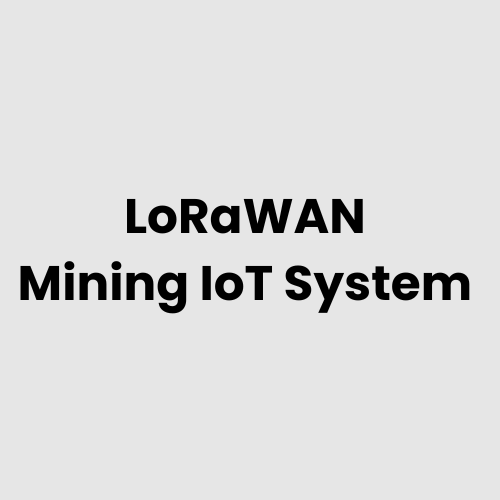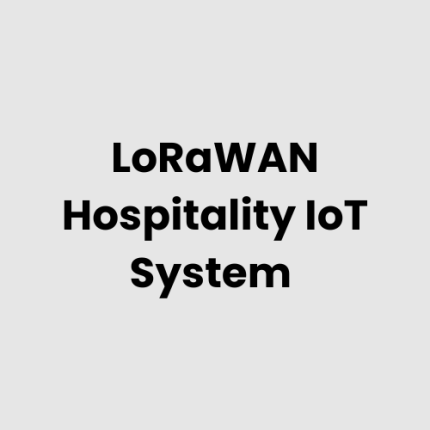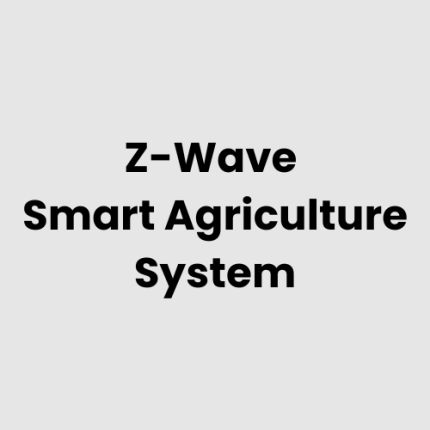Description
Technical Architecture of LoRaWAN Enabled Mining IoT System
The LoRaWAN Enabled Mining IoT System utilizes a multi-layered architecture to ensure seamless data flow and processing across the mining site:
- Sensor Layer:
- Includes a variety of IoT sensors that monitor environmental conditions (e.g., gas levels, temperature, humidity) and machinery health (e.g., vibration, pressure).
- Gateway Layer:
- LoRaWAN gateways act as intermediaries, collecting data from sensors and transmitting it over long distances to edge devices or cloud-based platforms.
- Edge Computing Layer:
- Provides local data processing, reducing latency and ensuring rapid decision-making when required.
- Cloud Platform Layer:
- Centralized cloud-based management and analytics platform for data aggregation, reporting, and real-time decision support.
This architecture ensures optimal coverage, minimal latency, and the ability to handle the unique challenges of a mining environment.
Hardware of LoRaWAN Enabled Mining IoT System
- IoT Sensors:
- Gas detectors, temperature sensors, humidity monitors, and vibration sensors for real-time environmental and equipment monitoring.
- LoRaWAN Gateways:
- Outdoor, ruggedized devices capable of long-range communication to relay data between sensors and processing units.
- Edge Computing Devices:
- Local processing units that filter and analyze data at the mining site before transmitting it to the cloud or central servers.
- Power Solutions:
- Renewable energy sources such as solar panels or backup batteries for power in remote areas where grid connectivity is unavailable.
- Communication Infrastructure:
- Robust wireless communication infrastructure to ensure reliable data transmission across various terrains.
Physical Placement Considerations of the Hardware
- Sensor Placement:
-
- Sensors should be positioned in high-priority areas, such as near heavy equipment, underground shafts, and hazardous zones.
- Placement must account for environmental factors like extreme temperatures, dust, and moisture, ensuring the equipment is weatherproof and protected.
- Gateway Placement:
-
- Gateways should be installed at elevated points such as towers, buildings, or poles to maximize signal coverage across the mining site.
- Ensure minimal interference from natural obstacles (e.g., mountains, underground areas) and ensure they provide full coverage in remote zones.
- Edge Device Placement:
- Edge computing devices should be located near the critical equipment or sections of the site that require immediate data processing, ensuring that they are secure and temperature-controlled.
Hardware Architecture of LoRaWAN Enabled Mining IoT System
The hardware architecture is designed to optimize data collection, communication, and processing:
- Sensor Network: A large number of IoT sensors deployed across various points in the mining site, collecting real-time data.
- Gateways: These devices receive sensor data and transmit it over long distances using LoRaWAN, often connected to edge computing devices for local analysis.
- Edge Computing Devices: Process and filter sensor data to allow fast decision-making and reduce dependency on cloud-based systems in environments with limited connectivity.
- Cloud Platform: A centralized management system that aggregates all data from the mining site, allowing for advanced analytics, reporting, and visualization.
This tiered hardware setup ensures long-range coverage, data integrity, and high availability of critical information at all times.
Deployment Considerations of LoRaWAN Enabled Mining IoT System
- Site Survey:
- A detailed site assessment is necessary to determine the optimal locations for sensors and gateways based on terrain, obstacles, and site layout.
- Network Configuration:
- The network configuration should be tailored to the size of the mining operation, ensuring that there is adequate coverage for all critical areas, including underground mining zones.
- Power Supply and Backup:
- Power solutions should be considered, with solar panels or long-lasting batteries often recommended for remote areas that lack stable power sources.
- Scalability:
- Ensure the system is designed to scale as the mining operation grows, allowing for the easy addition of sensors, gateways, and devices without disrupting current operations.
- Maintenance:
- Regular maintenance schedules should be established for hardware components to minimize downtime and ensure the system operates smoothly.
List of Relevant Industry Standards and Regulations
- ISO 9001: Quality Management Systems.
- ISO 14001: Environmental Management.
- ISO/IEC 27001: Information Security Management.
- IEEE 802.15.4: Standard for low-power wireless communication.
- LoRaWAN Specification: LoRaWAN Communication Protocol.
- RoHS: Restriction of Hazardous Substances.
- Mining Safety Standards: Regulations from mining safety authorities (e.g., OSHA, MSHA).
Local Server Version of LoRaWAN Enabled Mining IoT System
For sites requiring localized control and reduced dependency on external networks, GAO Tek’s LoRaWAN Enabled Mining IoT System offers a local server deployment option. In this configuration, data is processed at the edge of the network, close to the mining operation, reducing latency and ensuring faster response times. The local server version is ideal for operations in remote or connectivity-challenged environments, providing an efficient and reliable solution for real-time decision-making.
Cloud Integration and Data Management
GAO Tek’s LoRaWAN Enabled Mining IoT System can be integrated with cloud platforms for advanced data management, analytics, and reporting. Key features of cloud integration include:
- Real-Time Data Aggregation: Collects data from sensors across the mining site and consolidates it in real time.
- Advanced Analytics: Leverages cloud-based tools to analyze data for predictive maintenance, operational efficiency, and safety enhancements.
- Remote Access: Enables management and monitoring from anywhere, with secure access through the cloud interface.
- Data Visualization: Dashboards and reports allow users to visualize key performance metrics and operational insights, improving decision-making across the mine.
By combining edge and cloud computing, GAO Tek’s LoRaWAN Enabled Mining IoT System delivers an end-to-end solution for monitoring, data processing, and analytics, ensuring that mining operations remain efficient, safe, and profitable.
GAO Case Studies of LoRaWAN Enabled Mining IoT System
United States Case Studies
- Phoenix, Arizona
A large copper mining operation in Phoenix implemented the LoRaWAN IoT system to monitor gas levels and machinery health in real time. The solution provided the team with immediate alerts to ensure the safety of their workforce, reducing accidents and downtime.
- Denver, Colorado
In Denver, a mining company used the system to monitor environmental conditions and track equipment usage in remote mining areas. The ability to analyze equipment data led to optimized maintenance schedules and enhanced equipment lifespan.
- Salt Lake City, Utah
A salt mining facility in Salt Lake City adopted LoRaWAN sensors to track humidity and temperature within the mine. Real-time monitoring allowed the company to manage storage conditions, improving product quality and minimizing material loss.
- Pittsburgh, Pennsylvania
In Pittsburgh, LoRaWAN sensors were deployed to monitor underground mine gas concentrations and air quality. This system helped the company maintain regulatory compliance while improving worker safety by providing early warning alerts.
- Minneapolis, Minnesota
A gold mining operation in Minneapolis integrated LoRaWAN devices for vibration monitoring of critical equipment. The data provided early warning signs for potential failures, reducing unexpected downtime and costly repairs.
- Chicago, Illinois
In Chicago, the system was implemented to monitor power consumption and optimize energy usage across a mining site. Real-time energy management significantly reduced energy waste and costs while improving operational efficiency.
- Houston, Texas
A Texas-based mining operation deployed the system to monitor soil moisture levels for excavation planning. The data improved excavation efficiency by providing precise moisture readings, reducing unnecessary delays.
- Las Vegas, Nevada
LoRaWAN sensors were used in a Nevada mining operation to track hazardous gas levels in real time. The system enabled swift action in dangerous conditions, safeguarding both workers and equipment while ensuring environmental standards were met.
- New York City, New York
A company specializing in aggregate mining in New York City utilized the LoRaWAN system to monitor air quality and dust levels around its operations. This system helped ensure environmental compliance and protect the health of workers in dusty conditions.
- Los Angeles, California
In Los Angeles, a mining company deployed LoRaWAN-enabled sensors to optimize equipment management. The system tracked mining truck utilization, allowing for improved fleet management, reducing fuel costs, and improving productivity.
- Boise, Idaho
An Idaho mining site used LoRaWAN to track water levels in nearby mining pits. By monitoring water table levels, the system helped mitigate flooding risks and enhanced operational planning during seasonal changes.
- Charlotte, North Carolina
A coal mining operation in Charlotte integrated LoRaWAN sensors to monitor conveyor belt performance and prevent malfunctions. The system provided predictive analytics, helping the company avoid costly downtime due to conveyor failures.
- Dallas, Texas
In Dallas, a lithium mining operation employed LoRaWAN devices to track the wear and tear on mining drills. This real-time data helped extend the lifespan of tools by allowing for timely maintenance and replacements.
- San Francisco, California
LoRaWAN-enabled sensors were used to measure vibration and seismic activity in a San Francisco mining project. This data enabled the team to assess stability risks, improving safety and operational planning for mining activities.
- Seattle, Washington
A Seattle-based mining company deployed LoRaWAN to monitor the performance of water filtration systems at a large mining operation. Real-time data collection ensured the systems were operating efficiently, reducing water waste and improving environmental stewardship.
Canada Case Studies
- Vancouver, British Columbia
A gold mining operation in Vancouver adopted the LoRaWAN IoT system to monitor the structural integrity of mining infrastructure. By using real-time data, the company detected early signs of wear, allowing for proactive maintenance and preventing costly damage. - Toronto, Ontario
In Toronto, a large-scale mining operation used the LoRaWAN system to monitor temperature and humidity in ore storage facilities. The IoT system helped optimize the storage environment, ensuring better preservation of mined materials and reducing losses due to spoilage.
Navigation Menu for LoRaWAN
Navigation Menu for IoT
- LORAWAN
- ZIGBEE
- Wi-Fi HaLow
- Z-WAVE
- BLE & RFID
- NB-IOT
- CELLULAR IOT
- GPS IOT
- IOT SENSORS
- EDGE COMPUTING
- IOT SYSTEMS
Our products are in stock and can be shipped anywhere in the continental U.S. or Canada from our local warehouse. For any further information, please fill out this form or email us.
We are actively looking for partners who are like us located in the U.S. and Canada. For more information on partnering with GAO, please visit Partner with GAO Tek Inc. It lists various ways to partner with GAO, such as OEM Partnerships, Technology Integration, Distribution and Reselling Opportunities, Presenting at the Leading Event Tek Summit, Joint R&D Projects, Training and Consulting Services, Industry-Specific Collaborations, Research and Academic Partnerships.



